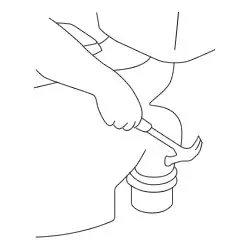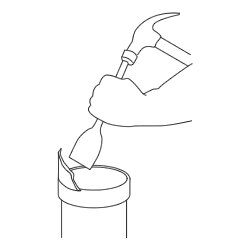Disconnecting the water and overflow pipes
Turn off the water supply to the cistern by locating a stop valve along the supply line or closing the supply from the tank in the attic.
Flush the toilet to empty the cistern.
Disconnect the overflow pipe by undoing its connection to the cistern with a pipe wrench.
Disconnect the flush pipe which runs from the cistern to the pan. If yours is a low- level close-coupled cistern, there will be no such pipe as the cistern is mounted directly onto the pan.
Disconnect the water feed to the cistern with a wrench or spanner. Since the set up is being replaced and new connections are going to be needed anyway, you can cut the pipes with a hacksaw close to the cistern if they are difficult to undo.
Remove fixing screws and lift the cistern out of the way.
Take care as these are often heavy and may well contain some residual water.
Removing the toilet pan

Remove any fixings holding the pan to the floor. Use a rocking motion to free the connection to the soil pipe and pull the connection out from the pipe.
Often the pan will be stuck firm and there really is no alternative to freeing it except by breaking the outlet connection. For this, use a hammer to smash the outlet – not the soil pipe.
Be sure to wear safety goggles to protect your eyes.

Old pans are sometimes cemented to the floor, in which case you may need to drive a cold chisel under the base to free it.
Remove the pan. Pack some old rag into the soil pipe (allowing for its removal later) so that broken pieces are not allowed to enter the pipe – and to prevents smells.
Clear the remaining piece from the soil pipe using a hammer and cold chisel if necessary, but take care not to damage the pipe if possible. Wear gloves as well since the broken pieces may well be sharp.
Soil pipe
If the soil pipe gets broken in the process, it will need to be trimmed back to provide a clean square end. The most efficient way to do this is to use a chain pipe cutter. These are usually available from hire shops. The chain cutter is wrapped around the pipe and worked backwards and forwards to cut the pipe. Most hire shops are very willing to show you how to use their equipment safely and efficiently so, if you don’t know how, ask.
